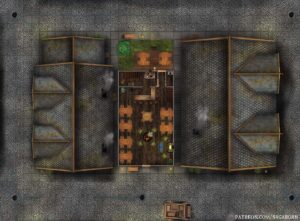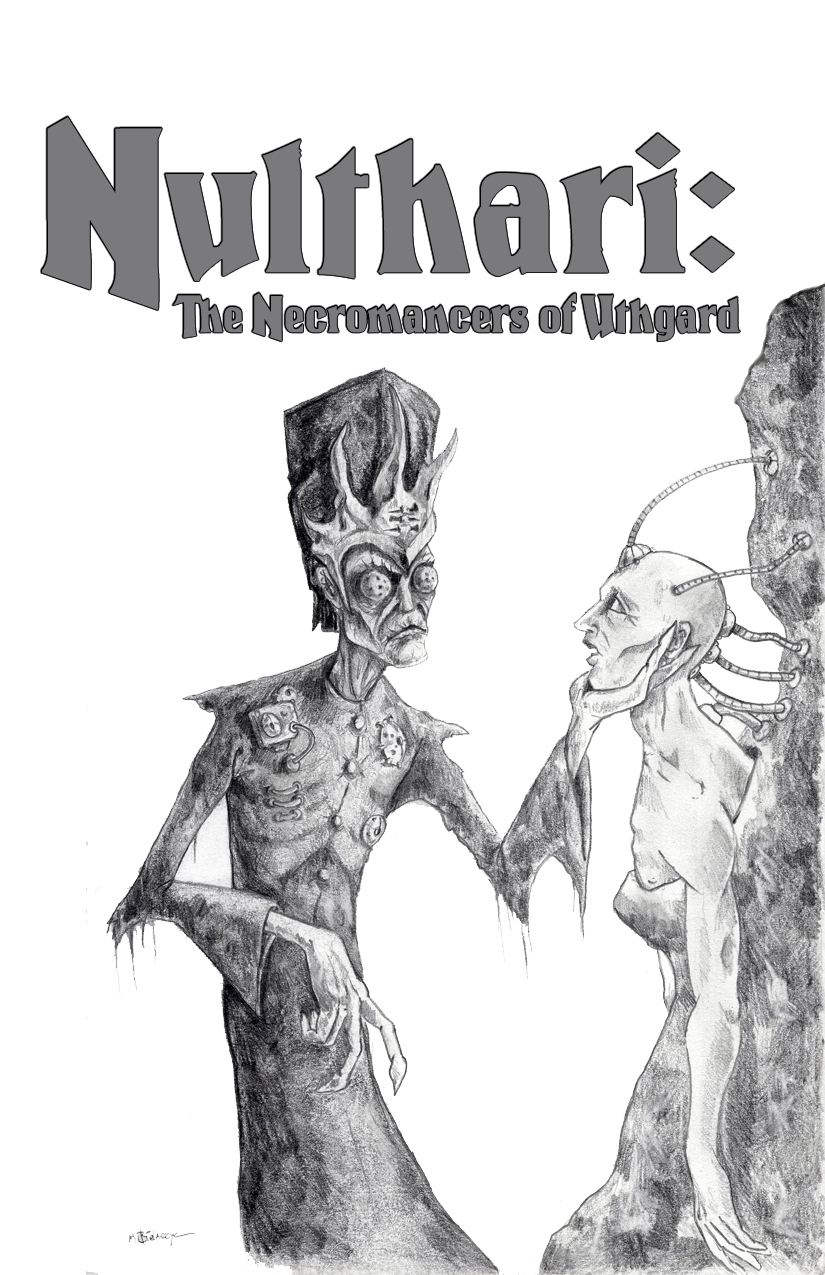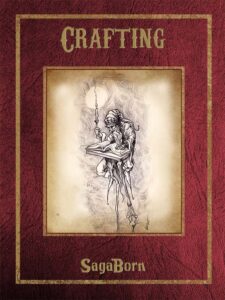- Writing: Michael Bielaczyc, Dane Clark Collins
- Cover Art: Michael Bielaczyc
- Interior Art: Michael Bielaczyc
Copyright Lone wanderer Entertainment, 2022.
Ravaging and Recovery / The Nulthari – Necromancers of the North / Frazetta / Into the World
Ravaging and Recovery
M. Bielaczyc
Before we get into how to recover from Ravage points, I guess I need to make sure all of you are familiar with Ravaging. Ravaging is a core magic mechanic for converting life energy into Mana, the fuel for spells in SagaBorn.
Ravaging Rules from the upcoming 1.5 Ruleset:
Ravaging: Ravagers
Ravaging is a way to gain mana for those who do not concern themselves with where the energy comes from—as long as it is not from themselves. Once they exhaust their mana points, the Ravager can attempt to continue casting spells by drawing on the life force of all living things around them.
Ravagers have no need to concentrate on where the energy originates from, and no concern for what is harmed by their evil acts. When casting spells in this manner, all living creatures within a specific radius of the spellcaster take physical damage. Ravaging always drains health and is not affected by Damage Reduction (DR). At the ravager’s discretion, one of the following occurs:
(1) All living creatures and flora within a 10 ft. radius take damage equal to the spell’s mana cost, or
(2) All creatures within a radius equal to 10 ft. times the spell’s mana cost take 1 hp of damage.
A Ravager’s act is instantly recognizable. Anyone within the circle feels their life essence drain from them, usually accompanied by a headache and chills. But even those outside of the affected radius are instantly aware. Small plants, such as grass and weeds, shrivel and turn black. Nearby lakes and streams become speckled with dead fish, and insects are instantly desiccated, like a cicada’s molted skin.
When a caster Ravages, they roll a d20. On a natural 1, they fail their casting check and will pull the mana directly from themselves, causing physical damage equal to the mana cost of the failed spell.
As Ravagers continue to perform these heinous acts, many experience physical changes to their appearance. The effects are subtle at first; dark bags under the eyes, a lingering cough, dry or chapped lips, and the like. The effects become more noticeable over time, as the Ravager displays sunken or discolored eyes, sickly complexion, and dark veins running under their skin, and so forth. Some scholars claim that tales of hideous twisted crones with greenish skin, long hooked noses, and warts were the result of Ravagers who overused their powers. If you choose to play a Ravager, be creative with the effects the magic has upon your character, to individualize and make your character distinctive.
Ravage Points
Every time a spellcaster Ravages, on purpose or by accident, their appearance can change as well as how others perceive them. As you gain Ravage Points, you become corrupted and your appearance shows it. An adventurer can rid themselves of Ravage Points by doing things the Storyguide deems as self-sacrificing or redemptive.
| Ravage Points | Corruptions |
| 1-2 | No appearance change. |
| 3-4 | Blemishes on face or nose, bags under eyes. |
| 5-6 | Dark shadows around eyes, bluish lips. |
| 7-8 | Pale skin, slight showing of veins. -1 to Persuasion skill checks. |
| 9-10 | Hair becomes stringy or turns gray or white, gain a cough. |
| 11-12 | Eyes become pale or bloodshot, fingernails elongate. -2 to Persuasion skill checks. |
| 13-14 | Eyes sink, skin becomes pale and sickly, with a yellow, green or bluish tint. |
| 15-16 | Loss of weight, people feel uncomfortable around you. -3 to Persuasion skill checks. Gain Ravaging Hunger |
| 17-18 | Teeth become stained or rotten and some might fall out, body stench. Ravaging Hunger |
| 19 | Stooped posture, pale skin becomes wrinkled or glossy. -4 to Persuasion skill checks. Ravaging Hunger |
| 20 | Eyes become all white. Cannot hide the aura of evil around you. Ravaging Hunger |
| 21-30 | Hair falls out, skin pulled tight over bones, lose 1 CON, -5 to Persuasion skill checks. Ravaging Hunger |
| 31+ | For every ten Ravage points after 30 you permanently lose 1 CON and gain an additional -1 to Persuasion checks. Ravaging Hunger |
Ravaging Hunger
If it’s been at least one day since you last Ravaged for spell energy, you become Fatigued. If it’s been two weeks, you become Exhausted. After four weeks, all of these effects fade, and you have broken your ravaging addiction. Any spell or effect that would remove these conditions instead suspends them for a period of one minute, after which they resume. Ravaging for any reason accidental or otherwise at any point in this process, including after your symptoms fade, will immediately relieve all of these symptoms, but you will have to start again from the beginning to attempt to break it again.
What about Recovery?
Ravaging is one of the core mechanics of Sagaborn that sets it apart from other RPGs with spellcasting. I have always followed a motto with magic, energy must come from somewhere. When following my ideas for fiction, I always saw magic as an analogy for technology, but also causing an absence of it. Like if you have one in a world, then the other wouldn’t work. And just like technology, I immediately felt that magic would always be abused and used to set the world on fire. So ravaging was born.
Well not really born, but more emerge out of a primordial soup of ideas about technology, the Force, and spellcasting from D&D. And of course I would be in the wrong if I didn’t point out how much I always loved Dark Sun and its defiling magic. So people using magic could use it responsibly, or they could abuse the world around them and cast as many spells as they wanted. But there is always a cost.
Originally, back in the first book we published – the Elves of Uteria, ravaging gave cosmetic effects to the mage the more they ravaged. But by the time we got to Sagaborn 1.0, we knew that there had to be more to it than that. It was still mainly cosmetic, but after a certain amount the character started to permanently lose Constitution. Besides that it was left up to the gamemaster and the GM. At my tables, the choice to ravage was never taken lightly and almost always led to more storytelling, which I considered a big win.
As we finish editing Sagaborn 1.5 and look to the future, we realize once again a little more needs to be said on the subject. Simply put, I was asked what the hell the single sentence in the rulebook meant for actually losing ravage points.
“An adventurer can rid themselves of Ravage Points by doing things the gamemaster deems as self-sacrificing or redemptive. “
So we want to give a little more description behind that, but that brings up, how do you balance between making something a hard choice and not making gameplay a burden? The best answer is leave it open ended for the gamemaster (soon to be upgraded to the new SagaBorn title: Storyguide) and player to decide, but still give enough information for the gamemaster to make a ruling.
First is the scale of damage caused by the ravaging. Was the act caused by the need to heal someone? Was the ravaging an act of greed and power? I do not think there should be a rating on each ravage point, but a gamemaster knows the intent behind the characters actions. They know if the character is moving towards being a power hungry warlord, or a mage who has to make hard decisions for the good of their friends. And a discussion with the player about what they want is always important.
Remember, this is a game and all people involved should be having fun!
With that in mind, here are some examples of gameplay, and how to lose ravage points.
Example 1
The battle is going bad. Elia is down on the ground, her life slowly slipping away. Vex is standing his ground with the golem, but he is bruised and battered, his second wind long gone. Soaron has flown off bobbing through the air, his wing badly damaged. Asher knows she must save her friends, but there she has no more mana to spend. She closes her eyes and pulls energy from the world around her. The plants wilt and the ground grows gray and lifeless, she holds out her hand and the stones nearby lift in the air and all hurdle at the golem, crushing it below the massive weight. The golem collapses to the ground, no longer moving.
This is a choice of saving her friends, not one of abuse. It is still very harmful to the environment of the planet, so it should not become a common practice. If this is how she uses ravaging magic, I as her GM would make it easier to remove ravage points.
Back in the town, the people are mourning the loss of their friends and family as many had died at the hands of the golem. So many that they are having a hard time burying and honoring their memories. Asher turns to her companions and urges them to stay and help the villagers build coffins and bury their dead.
If they do this, I would have Asher lose the Ravage Point she gained during the adventure.
Example 2
The bandits were still firing arrows down. Ulior knew his companions could route them out of their hiding place, but he grew bored with this cat and mouse chase. A quick decisive victory would spread word that Ulior was not to be trifled with. His mana had been drained much earlier in the battle, but it was of little consequence, there was plenty of energy giving life around him. He reached out, feeling the life inside the bandits and the surrounding trees. He ripped the energy from them and turned it into a swirling vortex of fire. The fire crashed down on the bandits and they screamed in pain from both the energy drain and the flesh burning from their bones. After nothing but blacked bones and gray ash remained in a circle where the bandits once perched. Ulior smirked, others would hear of this and rightfully fear him.
In this scene, Ulior took the easy way out. He abused life to end it. After this I would have a talk with the player behind Ulior and ask if this is the path he saw his character going. Does the character have remorse? Does the player want Ulior to redeem himself?
As you can see by these examples, and many more that I am sure you can imagine, each instance of ravaging could be wildly different and nuanced. So ravaging should be just that, a start of a nuanced storyline for the character. Maybe Ulior will have a story arc that involves him descending into a power hungry mindset, only to realize the error of his ways as he becomes attached to his companions. Maybe Asher finds herself constantly pulling energy from her enemies and slowly loses herself to the ease of ravaging. Ravaging and recovering points should encourage roleplaying and story, not make the game a chore.
But there have to be rules right?
Proposed New Ravaging Rules:
If a character ravages to gain mana, they gain a ravage point. Even if they are doing it for the best reasons, ravaging leaves a mark.
It takes at least one week in game to remove one ravage point. A character may do something that allows them to lose more than one point, but effects of ravaging only recede at the max rate of three points per week.
Besides these two rules, all the rest should be decided between GM and player, and should always add to the story!
Nulthari: The Necromancers of Uthgard
From the Encyclopedia Atheles
Nulthari is the name given to the mages who are a branch of the Ministry of the Arts called the Arcane Assembly. They look to gain power over life, to end suffering and disease, and conquer death. Some see this as an avenue to power, others see this as a way to stop the pain of those suffering. They also claim to be able to commune with the dead, but many believe that they are only speaking with those of the Navirim or the In-Between.
History
In the 3rd Age the Nulthari were the advisors to the Warlock King and were the chief strategists of the invasions to the South and West (The Great War). They perfected extending life and healed many diseases that the people suffered.
They also used ravaging magics to win the war leaving the world scarred.
In the current 4th Age, the Nulthari are part of the Ministry of the Arts and publicly model themselves after what they view as the good parts of the Nulthari from the 3rd Age. Though in any institution power reigns and many within their ranks once again search for answers over life and death. They also seek knowledge of their ancestors’ destructive and powerful magics.
The Warlock King was always concerned with power and death. He wanted to conquer both. And he tasked his greatest magical advisors to help him in the venture.
Ancient Nulthari organization
The Nulthari were originally only the closest mage advisors to the king of Uthgard, but as he demanded more they recruited more to their ranks. They were ruled by a small trio of high mages – Daloron, Thaymund Asmoden, and Senka Lazarius. Daloron and Lazarius saw their new underlings as little more than a means to an end, but Asmoden felt a responsibility to those under him. In the end, after the legend of the war all three were lost as were many of their followers.
Ancient Magical Contributions
Daloron and Asmoden helped invent the Spirit Valve, a magical body modification that allowed the transfer of spirit from one being to another. This is credited in allowing The Warlock King to live for so long.
Lazarius is often credited in the formulation of the rituals that allowed the massive collection of mana required for the most destructive of spells.
From Aledyn’s Journal
The landscape of the wastes is as alien as it is inhospitable. It can be hot and dusty, with windstorms blowing strange insects to get caught in your hair and clothing, or the gray dirt makes way to vast expanses of wetlands, humid and uncomfortable. The gray dust in the air gives the sky a strange purple hue, which could be beautiful if the air didn’t choke you the deeper the purple gets. We have all heard the stories, and some more fortunate have read the ancient texts and know of the “Great War”. We solemnly bow our heads and still feel regret that two rich nations decided to defile the world in a war about borders which are little more than lines on a paper map. We hear tales of the dusty wastes and the tough tribes of Terans who still inhabit these lands. Minstrels have sung of the two moons hanging low over a dry riverbed that snakes around the empty mountains where once a city stood. But none of these can instill the strangeness and discomfort these wasted lands instill as you travel the empty roads. This is the end game of greed, and a dire warning for the future.
Dangerous magicks
Of all the dangerous and unnatural things the Nulthari did, their rituals that broke the land to power their catastrophic spells was the worst. Their final spell against Aradan spoiled the lands for hundreds of miles and made the whole capital city of Seladar just disappear.
The Influence of Frank Frazetta
Dane Clark Collins; Creative Grimoire
Frank Frazetta’s paintings are works of dark magic. If you stare for a while, his paintings can make you forget that civilization exists, surrendering the notion that you’re protected from those monstrous creatures and cruel gods that tormented early humanity. An intense mythic force courses through his work, reaching below the consciousness and bringing to the fore ancient, primal feelings of dread and awe.
Why Frazetta’s art matters to me
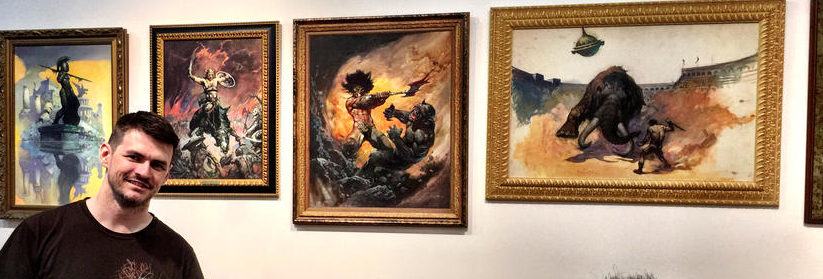
Grief can change the way the world looks, and that’s especially true when you’re a kid.
I was only 13, and the safety of my home had been destroyed by a series of tragedies. My family was a nightly fixture on the local news, and my friends didn’t come around. We lost our home. Only weeks earlier, we’d been a happy family, and now that was all gone. As the grief grew heavier, I looked everywhere I could for an escape.
Of course, it started with Conan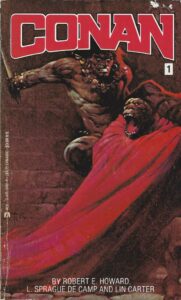
My mother and I were taken in by a family acquaintance, and all I had were my guitar and a small selection of paperback books to occupy my time. Several of these books had come from my father’s collection. As I flipped through them, deciding what to read next, one cover painting evoked some new emotion I’d never felt, and I couldn’t look away. Here was a painting that somehow reflected the grief I was feeling, but also showed the grit and determination to overcome the horrors of life.
It was the first Conan paperback by Lancer/Ace Books. This was not a hero in gleaming armor, as I’d learned to expect from other fantasy art. Nor was he a fearless warrior, facing down his enemies with confidence. Rather, Conan’s face evokes a mix of terror and fury as he faces his mortality against a primitive ape-like beast who cries in mutual terror and fury. This is not a battle of good versus evil, but a battle of survival, and one or both of the combatants will suffer a horrible death. The mood here is of brutal desperation in an ancient world, where terror of the unknown lurks in every shadow. I felt a deep sense of dread, and I wanted more of it, so I opened the book and started reading.
I read Conan, and then I read the next book in that series, Conan of Cimmeria. Again, I found myself mesmerized by the cover art as much as the words within. Here, we have Conan, not as a hero, but as a desperate man, utterly alone, struggling to survive a world determined to kill him. This time, he faces two massive men with axes and murderous intent.
But it was not the antagonists that held my attention. I was enthralled by the pale gloom and desolation of Conan’s surroundings as he faced his assailants in the lonely, secluded depths of icy mountain peaks. Staring into that painting, I could smell the frozen air as it bit into my skin. I could hear the winds whistle through the rocky terrain. There was no civilization here and no one to call to for help. There was only one man’s will against the frozen wasteland and two terrifying assailants.
As with many of Frazetta’s paintings, he detailed the landscape only vaguely, and yet it is that hostile, amorphous terrain that brought such feelings of dread to the surface of my consciousness—the terror of becoming lost in those exposed peaks and tenebrous valleys. Even if Conan somehow survives his struggle against these two giants, he may yet suffer a slow and lonely death, leaving a frozen corpse to quietly rot on some icy slope.
How Frank Frazetta inspired me
I can point to several turning points that enticed me to create stories and songs that take people on dark and mythic journeys. Frazetta’s book covers are among the earliest and most profound. I wanted to create art to help others feel the strange catharsis I’d felt, using my imagination to face those deep and primal fears that our modern society has buried deep in the psyche and forgotten, but that our collective memory can still sense lurking in the recesses of our minds.
I can’t explain why I would enjoy art that invokes existential dread and reminds me of the fears from which civilization has protected me. I’m not a masochist, and I’m not a sadist who enjoys the suffering of others, real or imaginary. Good stories help me feel less lonely, showing me that my fears and suffering are Universal, even if most of us prefer to suppress these feelings. I often yearn for a simpler time, when humanity lived in tribes, afraid of what existed out in the darkness but facing those fears together, sharing fantastic stories and hypnotic songs that bring our collective minds into communion with the chaos that surrounds us.
My trip to the Frazetta Art Museum
When I moved to the East Coast, one of the first things I did with my family was to make that pilgrimage to the Frazetta Art Museum in the Poconos of Pennsylvania.
As we came closer to the museum that was once Frazetta’s home, civilization gave way to mountain wilderness. The roads became narrow and tortuous until it felt like they no longer belonged here. We passed creeks, the trees grew taller, and deer roamed the countryside. It made sense. This was a man connected to nature and all its beauty and hidden dangers.
Inside the museum, surrounded by his original paintings, I was overwhelmed by the impression that Frazetta was a man born in the wrong time. His work was even more impressive and immersive in person, when I could see the brush strokes and textures of paint. The scenes felt alive, driven by the inspired movements of their creator, and the dangers felt real.
Old emotions I’d almost forgotten came back to me. I remembered what it felt like to be that kid, suffering terribly, but comforted, somehow, by these depictions of primitive pain and struggle.

New From Sagaborn
Into the World Darkwinter Tavern
Darkwinter Tavern
Darkwinter Tavern was opened after the long winter of ’93. Owned and run by Rob Bevaskin, a war veteran and ex merchant. He made his money taking supplies through the harsh lands between the neighboring cities, but “retired” by opening the tavern.
It is a popular place in Kowal for travelers, adventurers, and soldiers.
Menu:
- Poached Eggs and Kielbasa 8 sp
- Rabbit Stew and Hazelnut Bread 5 sp
- Bread Loaf 2 cp
- Cheese, hunk of 1 sp
Drinks
- Rye, shot 2 sp
- Rye, bottle 3 gp
- Ale, Pint (Breaker’s Brew) 4 cp
- Wine (Tiren Red Blend), pitcher 2 sp
